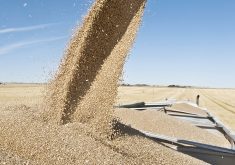Demand boosts beef
Fed cattle prices rose more than $1 per hundredweight last week as feedlots cleaned up their backlog and beef demand was strong.
Canfax says sales volume was down from the previous week, but still good for this time of year.
Prices in Alberta Jan. 15 were steers $83.25-$85.45 per cwt. and heifers $83.25-$86.50.
Canfax says beef demand is good and packers were asking $2-$3 more for wholesale beef prices. Beef sales in January and February will be critical to short-term cattle prices.
Read Also

India slaps 30 per cent import duty on yellow peas
India has imposed a 30 per cent duty on yellow pea imports with a bill of lading date on or after Nov. 1, 2025.
Asian troubles continued to hurt hide prices, dropping byproduct values by $2-$3 a head to $77-85.
The fed cattle outlook is for prices to rise $1-$2 per cwt. in the short term. The Canada-U.S. basis is expected to narrow.
Feeder cattle trade picked up last week, but volume is still light.
Canfax said heifer prices are steady to stronger. With plenty of pen space available, demand should be strong, Canfax said.
The stock cow trade was light with bred cows selling for $800-$1,000 and heifers $700-$900.
Hog prices improve
U.S cash hog prices jumped strongly late last week, up $3 to $39 per cwt. in Omaha Jan. 16, helping to boost Canadian prices.
Some of the gain may have been due to freezing rain over some areas of the corn belt.
For the second week in a row U.S. slaughter was more than two million, up more than 20 percent from this time last year.
Glenn Grimes, University of Missouri agricultural economist, believes U.S. production in 1998 could be up 10 percent from last year. If slaughter is up nine percent, then the U.S. will slaughter more than 100 million hogs this year.
Manitoba Agriculture noted that with one or two of the major processors having a Saturday kill, weekly hog slaughter in Manitoba is over 55,000 head, more than 50 percent above the level a year ago.














